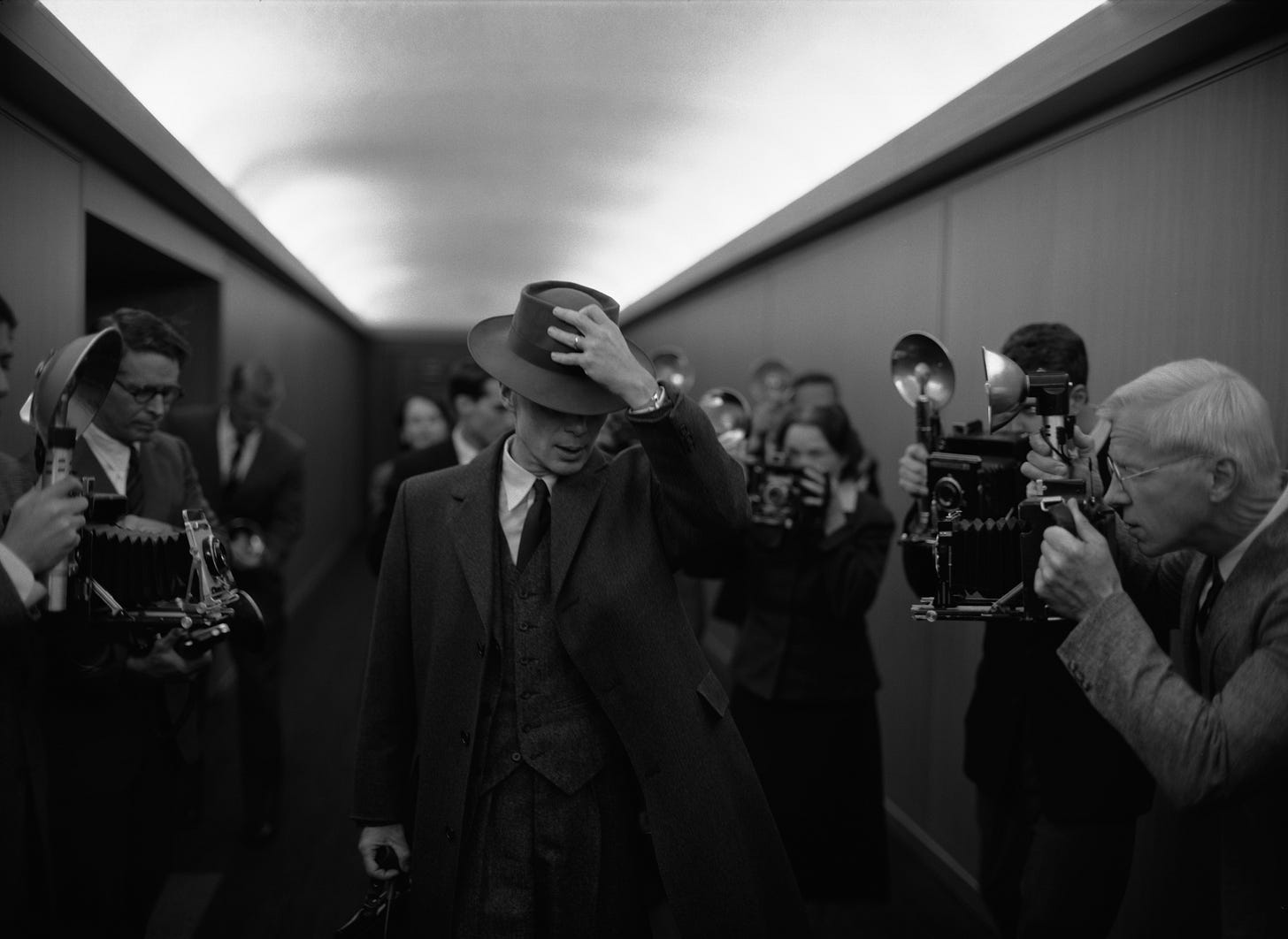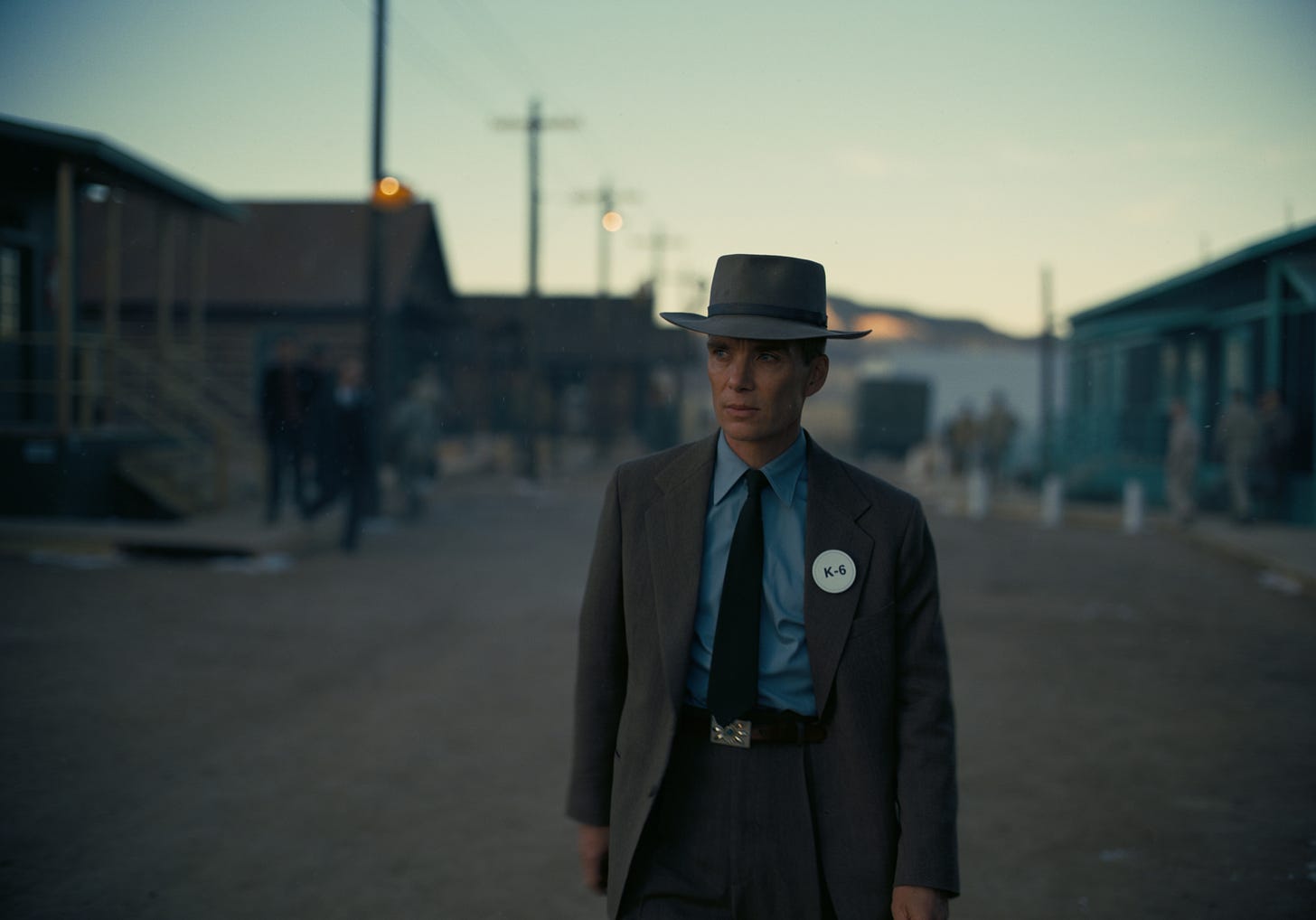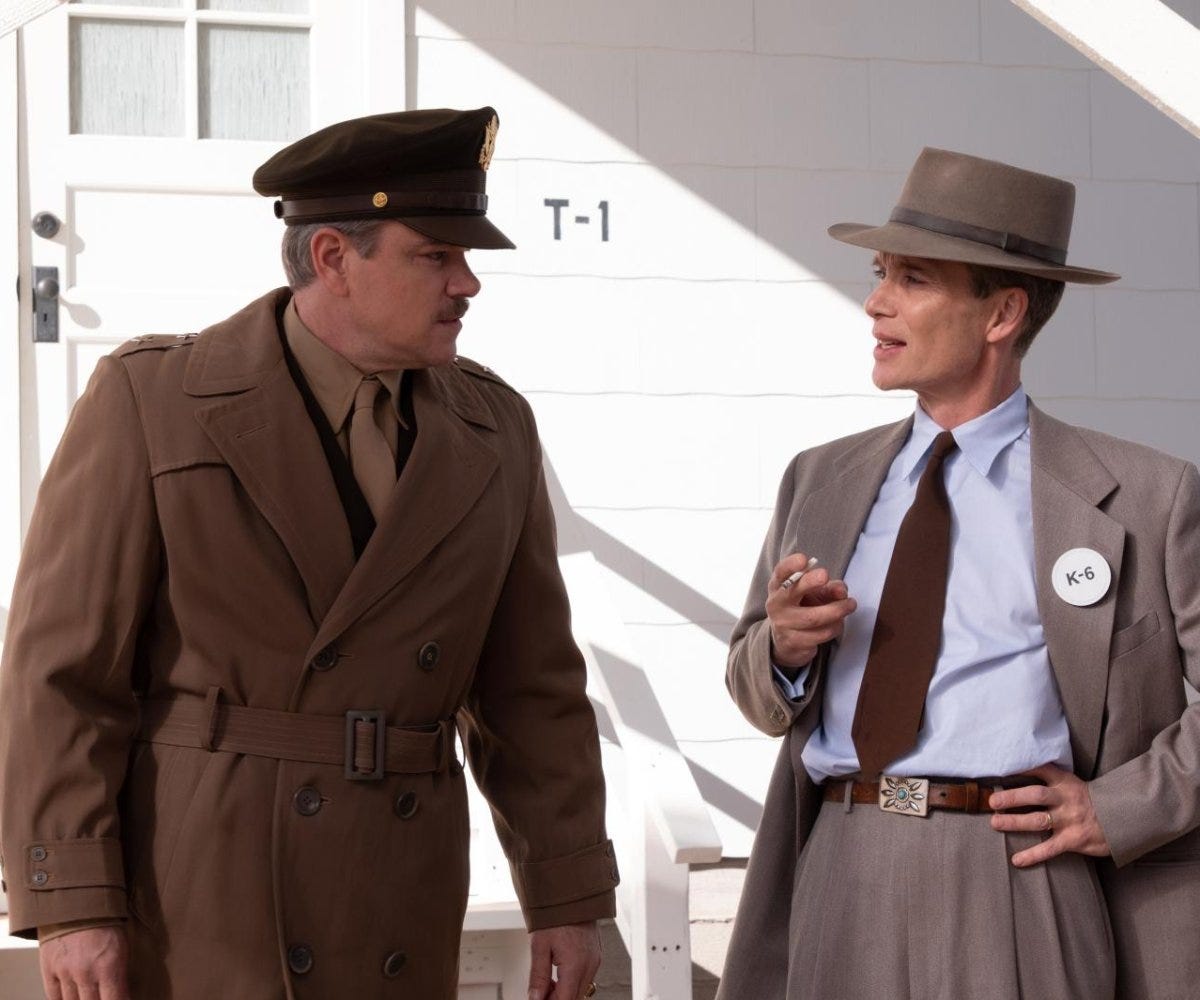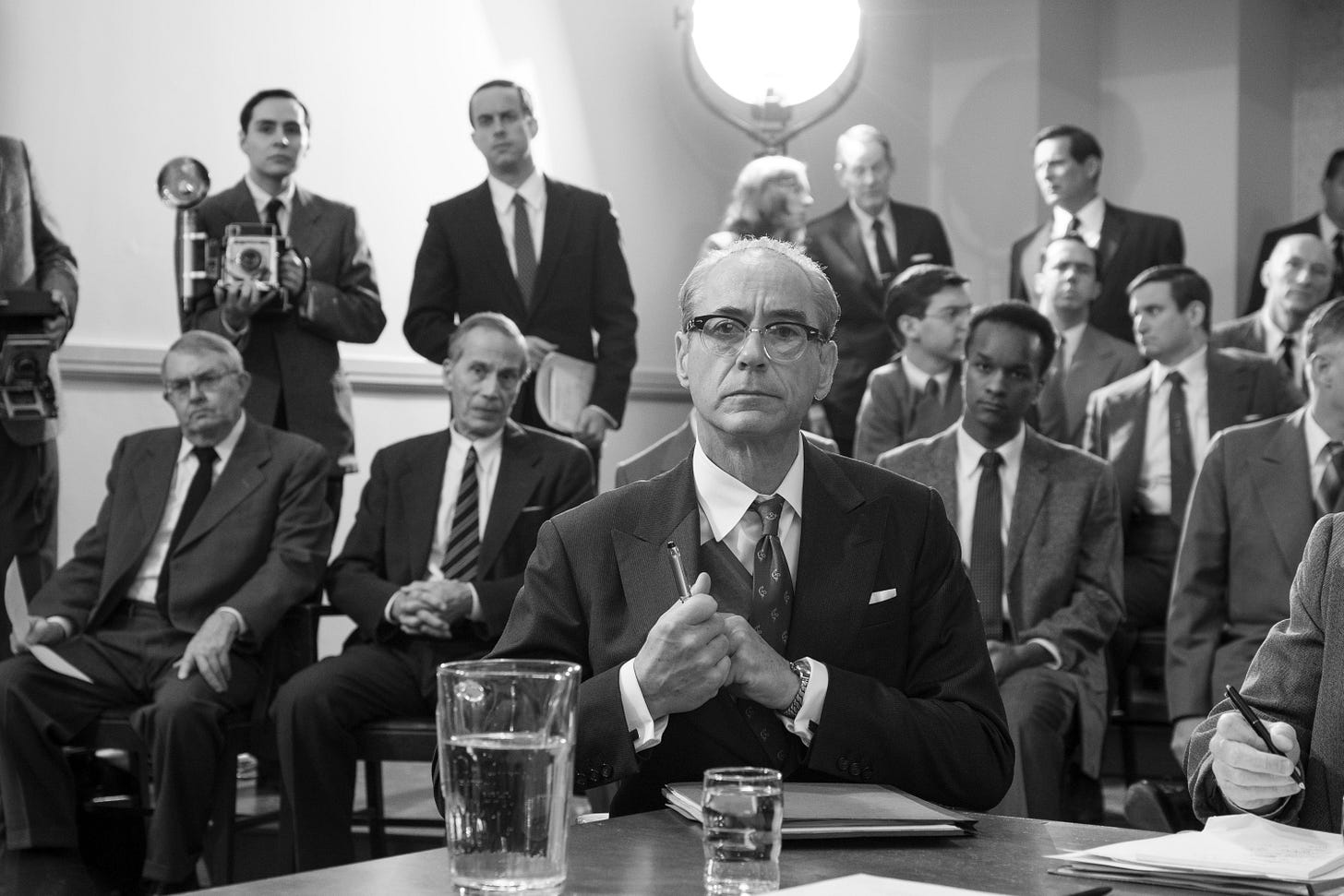"Barbenheimer" Weekend Pt. II: "Oppenheimer" (⭐ ⭐ ⭐ 1/2)
Christopher Nolan's epic of the Atomic Age is two-thirds of a great movie (and one third of a very good one).
The strength and sinew of “Oppenheimer” (⭐ ⭐ ⭐ 1/2, in theaters) starts with the actor playing the title role: Cillian Murphy is exactly the man you want at the center of an explosion. By “explosion,” of course, I mean the atomic bomb developed by J. Robert Oppenheimer’s Manhattan Project during World War II, but I also mean Christopher Nolan’s film about the building of the bomb. “Oppenheimer” is a movie that detonates with methodical force in several directions at once. It’s a story about a man trying to hammer the elements — the very atoms — into something terrifyingly powerful, a gift and a curse for mankind. But it’s also about an ambitious filmmaker marshaling his resources to give that story the weight and majesty it deserves. Murphy, an avatar of intense blue-eyed stillness, is the hub for the centrifuge, the cipher around which Nolan and his creative team set everything awhirl: History, politics, physics, ethics, the techniques of narrative cinema. A cast large enough to disappear over the horizon and, beyond that horizon, the ghosts of Hiroshima and Nagasaki – 129,000 to 226,000 men, women, and children violently destroyed by what Oppenheimer wrought.
Nolan has set out to make a moral epic, and he succeeds for the most part, or, rather, for the first two thirds of “Oppenheimer,” which contains some of the finest, most galvanizing moviemaking of his career. I’ve never quite bought into the breathless acceptance of this director as the Kubrick of his generation (in part because I’ve always had reservations about Kubrick as the Kubrick of his generation), and Nolan’s seriousness of purpose and meticulous craftsmanship have often risked stifling the spark of life, the chaos principle, that can animate great art. But here, even more than in “Dunkirk,” he has a subject to match his canvas: The effort by which a bickering army of international scientists met in the desert to create “a weapon to end all wars” – that was the hope, anyway – under the eyes of the U.S. Army and one mercurial, womanizing genius. Confidently entwining several overlapping timelines, filming in color and lustrous black and white, and parceling his narrative into two baskets labeled “Fusion” (the coming together of the Manhattan Project) and “Fission” (the splitting apart of the group’s loyalties during the McCarthy Era), Nolan masterfully tacks between the micro of Oppenheimer’s personal life and the macro of global conflict.
Oppenheimer was a New Yorker who fell in love early on with the landscape of New Mexico; who came of age as a brilliant young Jewish physicist in a Europe where post-Great War antisemitism was gathering steam. He was at the cutting edge of quantum theory in Germany and brought it back to America, where he taught at Berkeley and made the connections that positioned him as a Big Mind to lead other Big Minds after US intelligence learned the Nazis were working on a megabomb and decided to get there first. (There’s an excellent 1981 documentary playing on the Criterion Channel until the end of the month – “The Day After Trinity; J. Robert Oppenheimer & The Atomic Bomb” – should you want to brush up on the subject.)
Oppenheimer mixed with Socialists and American Communists in the inter-war period without fully committing to the Party, and that position – half principle and half cussedness – made him a security risk during the war and a convenient target afterwards. Nolan and Murphy portray the man as less interested in politics and more charged by what could be done in the vast inner spaces that quantum theory had discovered. To that end and under his Army overseer Major Gen. Leslie Groves (a bluff Matt Damon), Oppenheimer suggests building an entire town out in his beloved New Mexico and peopling it with his scientific peers. The race is on, Oppenheimer’s government minders mistrusting him on one side – Casey Affleck and Dane DeHaan are each uniquely chilling as two of the doubters/tormentors – and, on the other, the physicists passionately debating the morality of what they’re doing. This is where Murphy’s natural sang-froid proves most valuable: In Nolan’s version of the tale, Oppenheimer is not so much a peacemaker but an enigmatic, unstoppable engine of discovery. He’ll put up with the Army’s paranoia and the fractiousness of his fellow scientists as long as it takes, because he’s driven by the desire to see what will happen.
As the many dancing parts of “Oppenheimer” work toward the climax of the Trinity Test – the first exploding of an atomic weapon at Alamogordo on July 16, 1945 – Nolan builds the suspense with all the techniques at his disposal. Hoyte Van Hoytema’s fluid camerawork seems to be everywhere at once and Ludwig Göransson’s score walks right up to and sometimes over the line of overkill, dragging us along with it. When the detonation comes, though, the film falls silent, as is fitting for a breaking point in human history. The only movement aside from the angry mushroom cloud on the horizon is the silhouetted figure of J. Robert Oppenheimer looking at – finally seeing – what he has done.
And after that? Everything goes to pieces, including to some degree the movie itself. Nolan is wise not to dramatize the bombings of Hiroshima and Nagasaki; instead, he lets its horrors seep into the mind and imagination of Oppenheimer as the Los Alamos scientists celebrate. Up to this point, the film has been dramatizing the wartime Manhattan Project alongside two hearings in the post-WWII era, one a secret panel of hostile Congressmen charged with renewing Oppenheimer’s security clearance in 1954 and the other the 1958 confirmation hearings for Commerce Secretary nominee Lewis Strauss (Robert Downey Jr.), Oppenheimer’s former boss at the Atomic Energy Commission and a bitter enemy of the scientist.
These two strands take up the last hour of “Oppenheimer,” and, to be blunt, they could have made their point – the humbling of Prometheus – in half the time. The narrative excitement Nolan has built with care and craft is allowed to dissipate; the air leaks out of the movie. The toggling between color and black and white starts to seem baroque, and the huge cast that has seemed so crucial to the sense of history rolling inexorably forward – Kenneth Branagh as Niels Bohr, Benny Safdie as Edward Teller, Tom Conti as Albert Einstein, actors like Rami Malek, David Krumholtz, Josh Hartnett, Matthew Modine, and Jason Clarke as physicists and politicians – dwindles into Gary Oldman’s sideshow turn as Harry Truman. Sadly, Downey Jr.’s finely calibrated performance is allowed to go hambone in the final scenes, when Strauss flies into a spittle-flecked rage upon learning his political ambitions may be thwarted.
(A word, too, about the women of “Oppenheimer”: Underused. As Kitty Oppenheimer, Emily Blunt smolders, smokes, sneers, and is saddled with a succession of unruly infants – there is not a child in this movie that is not a crying irritant. As Jean Tatlock, the psychiatrist and Party member with whom Oppenheimer had a relationship before and during his marriage, Florence Pugh performs many of her scenes in the nude for reasons that elude me and possibly the filmmaker. The gifted actress Olivia Thirlby is briefly glimpsed and gets about one and a half lines of dialogue as Lilli Hornig, one of the few women scientists at Los Alamos. )
That final hour is doubly disappointing for the brilliance of the two hours that have preceded it. You may not mind. “Oppenheimer” captures the rapture and dread of perhaps the most critical moment in our species’ journey toward apotheosis and/or annihilation: A group of men and women holding their collective breath in a nighttime desert, waiting for an atom to split and the false sun of the future to rise.
The Watch List will return on July 31. Enjoy the week and your weekend and, as usual, I welcome your thoughts, stray or otherwise.
If you enjoyed this edition of Ty Burr’s Watch List, feel free to pass it along to others.
If you’re not a paying subscriber and would like to sign up for additional postings and to join the discussions — or just help underwrite this enterprise, for which the author would be very grateful — here’s how.
Give a paid Watch List gift subscription to your movie-besotted friends —
Or refer friends to the Watch List and get credit for new subscribers! When you use the referral link below, or the “Share” button on any post, you'll receive special benefits:
Get a 1 month comp for 3 referrals
Get a 3 month comp for 5 referrals
Get a 6 month comp for 25 referrals. Simply send the link in a text, email, or share it on social media with friends.
There’s a leaderboard where you can track your shares. To learn more, check out Substack’s FAQ.







